
A few quick, interesting facts about a different topic each entry. It's like an apple a day: pleasant, good to have, and pocket-sized.
Friday, October 31, 2008
Sunday, October 26, 2008
Apple #348: Woolly Bears
Woolly Bear caterpillars, that is.

Woolly bear or woolly worm caterpillar
(Photo from Dr. Jeff Masters' WunderBlog)
A couple weeks ago, I saw one scurrying on its multiple, stubby little legs across the sidewalk. I haven't seen a woolly bear in years. I got a stick and put it in the caterpillar's path. After some hesitation, the caterpillar climbed on, and I walked for a while carrying the woolly bear on the stick.
More of its spiky fur -- if it can be called fur -- was brown than black. My mom's cousin who has a farm used to say that if a woolly bear has more brown, that means the upcoming winter will be mild. More black than brown, the winter will be harsh. Lots of people think that about woolly bears -- that they somehow know what the upcoming winter will be like and color their fur accordingly, kindly letting us in on their prognostication.

The woolly bear in its defensive posture. This is serious business as far as the woolly bear is concerned, never mind how cute and round and fluffy and funny-looking it is to us.
(Photo from WiseAcre Gardens)
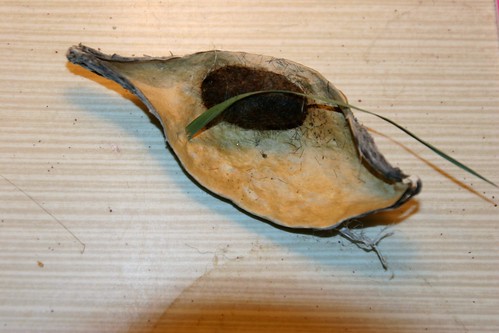
Woolly bear in a finished cocoon, which is lying inside a milkweed pod.
(Photo by Ann on flickr)
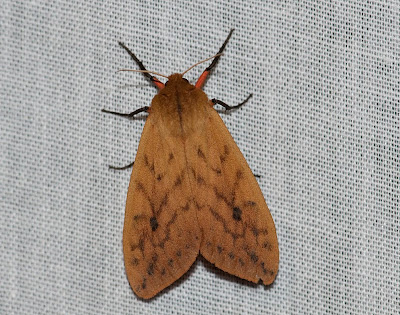
What the woolly bear caterpillar turns into: the Isabella Tiger Moth.
(Photo from EastTennesseeWildflowers)

The same moth with its wings spread a bit.
(Photo from Wing Watchers)
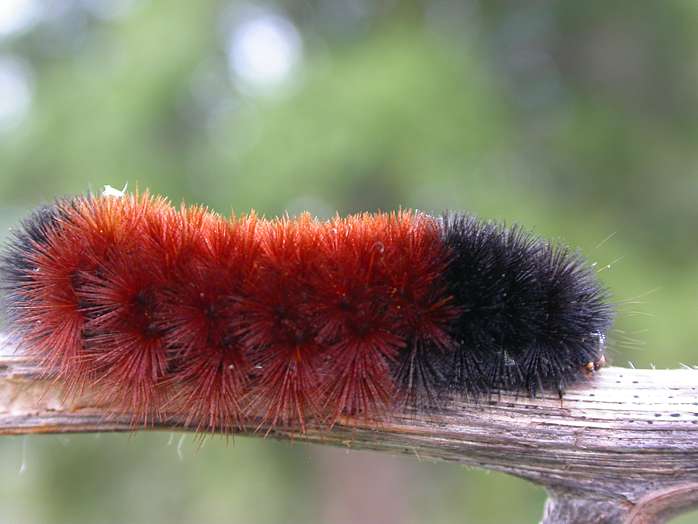
Several bands of brown.
(Photo from Nathan Cook's site of naturalist photos of Grand Island, New York)

Fewer bands of brown. This one has had more to eat than the one above.
(Photo from Ecobirder)

This is 2011's winner, YoYoMa, on the nose of owner Matt Buckland. YoYoMa's winter forecast is very detailed, week by week. In general, he says it will be cold and snowy.
(Photo from the official Woolly Worm Festival in Banner Elk)
Sources
Old Farmer's Almanac, The Truth About Woolly Bears
Iowa State University Department of Entomology, Woollybear
Woolly Worm.com, A Closer Look at the Woolly Worm
Bill Oehlke's tiger moth pages, Isabella Tiger Moth

Woolly bear or woolly worm caterpillar
(Photo from Dr. Jeff Masters' WunderBlog)
A couple weeks ago, I saw one scurrying on its multiple, stubby little legs across the sidewalk. I haven't seen a woolly bear in years. I got a stick and put it in the caterpillar's path. After some hesitation, the caterpillar climbed on, and I walked for a while carrying the woolly bear on the stick.
More of its spiky fur -- if it can be called fur -- was brown than black. My mom's cousin who has a farm used to say that if a woolly bear has more brown, that means the upcoming winter will be mild. More black than brown, the winter will be harsh. Lots of people think that about woolly bears -- that they somehow know what the upcoming winter will be like and color their fur accordingly, kindly letting us in on their prognostication.
- Woolly bears are the larvae of the Isabella tiger moth (Phyrrharctia isabella). It is very common in the US, Mexico, and southern Canada.
- There are actually several different types of woolly bear caterpillars. They vary in color -- yellow, green, white, tan, etc. The one we're talking about here is the banded woolly bear.
- The hair on a woolly bear is called bristles or setae. They are grouped with several other "bristled" species.
- Only the legs on the first three segments of the woolly bear's body actually work. The other sets of legs behind those are "false" legs. The last leg on the back segment helps prop up the woolly bear as it reaches for leaves and other food.
- They can't see very well, so they'll often rear up and kind of feel around for where to go next.
- The woolly bear has two "defensive postures," as the scientists call it. When disturbed, they will either curl up into a ball or run away as fast as they can. For some reason, this cracks me up.

The woolly bear in its defensive posture. This is serious business as far as the woolly bear is concerned, never mind how cute and round and fluffy and funny-looking it is to us.
(Photo from WiseAcre Gardens)
- Woolly bears, unlike some other kinds of caterpillars, don't congregate together. They like to go off by themselves. So if you see more than one woolly bear at a time, you've encountered something rare.
- Woolly bears like to eat
- dandelions
- clovers
- weeds
- leaves of maples, asters, and birch trees
- if you're feeding them, they will eat spinach or cabbage
- Usually, their quest for food takes them alongside roadsides or sidewalks, so that's why you often find them galumphing along in those sorts of places.
- Actually, two generations of woolly bears are born in a year. The first round appears in May and the second in August. I'm not sure why, but we tend not to see the spring crop of woolly bears, only the ones in the fall.
- Once they've eaten their fill, they'll go off looking for a place to sleep through the winter and work on becoming moths.
- They like to nestle under tree bark or in cavities in rocks or in the nooks of fallen logs and spin their cocoons there.

Woolly bear in a finished cocoon, which is lying inside a milkweed pod.
(Photo by Ann on flickr)
- If you find a woolly bear in hibernation state in late fall and bring it inside, it will warm up quickly and need food right away. If you want it to stay alive and become a moth, put it in a container with no food and no air holes -- counterintuitive, I know -- and put it in your refrigerator right away. It will go back to sleep until spring. Once spring comes around and there's vegetation available again, you'll have to give it food in its little container in the refrigerator for it to spin a cocoon and turn into a moth.
- Bill Oehlke, who raises moths and butterflies, has lots more tips about caring for the caterpillars.

What the woolly bear caterpillar turns into: the Isabella Tiger Moth.
(Photo from EastTennesseeWildflowers)

The same moth with its wings spread a bit.
(Photo from Wing Watchers)
- In 1948, one entomologist, Dr. C. H. Curran, decided that he wanted to find out if there was any truth to this folklore about the relationship between the color of a woolly bear's bristles and the forthcoming winter.
- He studied the woolly bears for 8 years, and he did find that on average, around 5 of the 13 segments of the woolly bears during those years were brown. In other words, they were mostly brown. As it happened, the winters during those years were milder than average.
- Before you get too excited, although Dr. Curran watched those woolly bears during those 8 years, he didn't keep an eye on very many of them. So he knew his data sample was small and therefore not very reliable.
- More recent research has shown that the coloring of woolly bears may be related to the levels of food and moisture in the areas where the woolly bear was born and raised. The better fed the caterpillar, the less brown it will be.

Several bands of brown.
(Photo from Nathan Cook's site of naturalist photos of Grand Island, New York)

Fewer bands of brown. This one has had more to eat than the one above.
(Photo from Ecobirder)
- Lots of people still hold onto this idea about the woolly bears and weather forecasting abilities. Elementary school classes often conduct scientific experiments involving woolly bears and weather. Newspaper columnists write about the woolly bear's predictions.
- The good folks in Banner Elk, North Carolina, hold an annual Woolly Worm Festival (they're worms, not bears in Banner Elk) each October. Participants race their hand-picked woolly bears. The champion caterpillar is inspected by the judge, who then pronounces the forecast for the coming winter based on the winning woolly worm's coloring.

This is 2011's winner, YoYoMa, on the nose of owner Matt Buckland. YoYoMa's winter forecast is very detailed, week by week. In general, he says it will be cold and snowy.
(Photo from the official Woolly Worm Festival in Banner Elk)
- The owner of the winning woolly worm also wins a $1,000 prize.
- Festival-goers say the woolly worms' predictions have been 70% accurate.
- There's a similar Woollybear Festival held each year in Vermilion, Ohio. They, too, have a woolly bear race (the Woollybear 500), but they also have a parade, a costume contest for men, women, and pets, and a breakfast hosted by Miss Vermilion.
Sources
Old Farmer's Almanac, The Truth About Woolly Bears
Iowa State University Department of Entomology, Woollybear
Woolly Worm.com, A Closer Look at the Woolly Worm
Bill Oehlke's tiger moth pages, Isabella Tiger Moth
Sunday, October 19, 2008
Apple #347: Pumpkins
Hey, it's Fall.

(Photo from Cooking from the Market, which has a recipe for pumpkin soup)
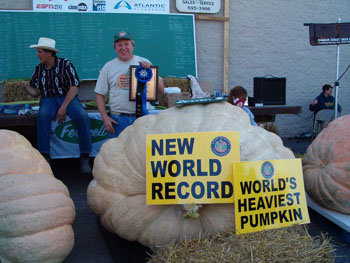
There is actually a club for people who have grown pumpkins that weigh over 1,100 pounds. It's called the called the 1100 Club. This guy, Larry Checkon from North Cambria, PA, is a member and also a former world record-holder, with his pumpkin which weighed 1,469 pounds.
(Photo from the Pumpkin Nook)

Paula Deen's pumpkin pie
(Photo from the Food Network)

The University of Illinois is in Champaign. All the pumpkins are in nearby Peoria. Barack Obama's house is in Chicago.
(Map from Joel Ward's real estate seminars)

This drawing called "The Pumpkin Effigy" appeared in The Ladies Floral Cabinet in September 1875.
(Photo from Inspiration Line)

Since the idea of the Jack O'Lantern is to scare off Stingy Jack who was kind of a rotten guy, I wonder which would work better, a happy face or a scary face.
(Photo from Wikimedia Commons)
It's a pumpkin extravaganza at The Pumpkin Show in Circleville, Ohio. The 2008 Pumpkin Show was this past weekend, but you can go again in 2009, on October 21-24. They have a largest pumpkin contest, a Miss Pumpkin pageant, a carnival at night, and not just one parade, but several.
(Photo from the Circleville Pumpkin Show)
Sources
University of Illinois Extension, Pumpkin Facts,
History Channel, The Real Story of Halloween
Penumbra, The Story of Stingy Jack
The Pumpkin Patch
The Pumpkin Nook

(Photo from Cooking from the Market, which has a recipe for pumpkin soup)
- Pumpkins are a fruit.
- The seeds are within the part you eat, which makes pumpkins, like all of its squash cousins, a fruit.
- They are also 90% water.
- The largest pumpkins get to be around 1,000 pounds.

There is actually a club for people who have grown pumpkins that weigh over 1,100 pounds. It's called the called the 1100 Club. This guy, Larry Checkon from North Cambria, PA, is a member and also a former world record-holder, with his pumpkin which weighed 1,469 pounds.
(Photo from the Pumpkin Nook)
- A ripe pumpkin will have a hard shell that won't dent or scratch easily when you press your thumbnail to it.
- Also, don't choose a pumpkin with any soft spots, cracks, splits, or bug holes.
- Pumpkins originated in Central America, but they can be grown just about anywhere in the world. Antarctica is the only continent where people haven't been able to grow them.
- In colonial times, when people used pumpkin in their pies, they baked it into the crust.
- The colonial ancestor of the pumpkin pie was a roasted pumpkin:
- Cut off the top
- Scoop out the innards & the seeds
- Fill it up with milk, spices, and honey
- Bake the squash in hot ashes

Paula Deen's pumpkin pie
(Photo from the Food Network)
- You can also find lots of recipes for pumpkin pie and just-about-anything-pumpkin at the U of Illinois Extension Service.
- 90% of the pumpkins grown in the United States are grown within a 90-mile radius of Peoria, Illinois.

The University of Illinois is in Champaign. All the pumpkins are in nearby Peoria. Barack Obama's house is in Chicago.
(Map from Joel Ward's real estate seminars)
- Connecticut Field is the variety of pumpkin that people most commonly use for carving.
- People have carved pumpkins for centuries.

This drawing called "The Pumpkin Effigy" appeared in The Ladies Floral Cabinet in September 1875.
(Photo from Inspiration Line)
- The phrase "Jack o' Lantern" refers to an Irish legend about a guy named Stingy Jack and the Devil:
- The Devil heard about Stingy Jack, so he invited Stingy Jack to have a drink with him. But Stingy Jack, being stingy as well as being a drunk, didn't want to pay for it. The wily Devil, thinking had Jack right where he wanted him, said he'd turn himself into a coin that Jack could use to pay for the drink. Stingy Jack agreed. Except then he put the Devil-coin into his pocket where he also had a silver cross, which prevented the Devil from changing back into his fully Devilish self.
- Once the Devil cried Uncle, essentially, Jack said he'd let him out of his pocket only if the Devil agreed not to bother him again for a whole year. During that time, if Jack should die, the Devil wouldn't get to have his soul. Sick of being a coin, the Devil agreed and once he was back to his old self, let Stingy Jack alone.
- A year later, the Devil came back. He told Jack he'd come to collect. Stingy Jack said he'd go with the Devil, but first, would the he climb up that tree and get Jack an apple? The Devil thought he'd already gotten Jack to agree to go with him, so he climbed up the tree. While he was up there, Jack put crosses all around the tree, which kept the Devil from climbing back down again.
- Once again, the Devil yelped for help. Jack said he'd let him out of the tree if the Devil agreed never to take his soul. The Devil agreed and Jack let him go.
- Finally, Stingy Jack died. But because he'd been a stingy drunk and a liar as well, he wasn't allowed into Heaven. So he got sent down to Hell, but when he got there, the Devil wouldn't let him in. Not only was the Devil still mad at him, but he'd given his word that he wouldn't take Jack's soul.
- So the Devil kicked him back up to Earth and gave him nothing but a burning ember to light his way. Stingy Jack put the coal into a carved-out turnip and carried it like a lantern, and he roams the earth this way to this day. So he became known as Jack of the Lantern, or Jack O'Lantern for short.
- By the way, people in Ireland and Scotland used to carve faces into turnips and beets and then light them with candles. This was to frighten away Stingy Jack and any other unsavory spirits who might be wandering about. When the Irish immigrants got to North America, they discovered that pumpkins worked really well for the purpose of making Jack O'Lanterns, and that's how we got pumpkin carving.
Since the idea of the Jack O'Lantern is to scare off Stingy Jack who was kind of a rotten guy, I wonder which would work better, a happy face or a scary face.
(Photo from Wikimedia Commons)
- Before Halloween, there was the Celtic harvest feast of Samhain (pronounced sow-ane). It started at sunset October 31 and lasted until sunset November 1. Its purpose was nothing spooky or devilish; it was simply a harvest feast. Samhain means "Summer's End."

It's a pumpkin extravaganza at The Pumpkin Show in Circleville, Ohio. The 2008 Pumpkin Show was this past weekend, but you can go again in 2009, on October 21-24. They have a largest pumpkin contest, a Miss Pumpkin pageant, a carnival at night, and not just one parade, but several.
(Photo from the Circleville Pumpkin Show)
Sources
University of Illinois Extension, Pumpkin Facts,
History Channel, The Real Story of Halloween
Penumbra, The Story of Stingy Jack
The Pumpkin Patch
The Pumpkin Nook
Tuesday, October 14, 2008
Apple #346: Silly Putty

Silly Putty. Just because.
(Photo from Games & Jigsaws, where you can buy an egg of Silly Putty for $1.79.)
- Silly Putty became a toy sort of by accident. Originally, during World War II, Japan was invading lots of countries where the US got its rubber, so rubber was less and less available. So the government asked scientists to come up with a synthetic alternative.
- In 1943, a scientist named James Wright who was working for General Electric mixed silicone oil with boric acid and got something stretchy and bouncy.
- Silicone is a rubbery, bouncy substance that is made up of alternating atoms of silicon and oxygen.
- Boric acid is an acid, but it's a relatively weak one. It's used as an antiseptic (i.e., to clean wounds), and together with other materials as a fire retardant or in adhesives (glue) or detergents.
- Never fear, the resulting Silly Putty is non-toxic.
- Anyway, he thought his bouncy stuff might just be the synthetic rubber the gov'ment was looking for. So he shopped it around to various scientists and engineers, but nobody could figure out a practical use for it.

Lifting images using Silly Putty is one of its most common uses. An entirely practical application.
(Photo from HowStuffWorks)
- Then in 1949, a woman who owned a toy store in New Haven, where James Wright was from, saw the bouncy stuff and thought it would make a fun toy. So they advertised it in her catalog for $2. It wound up outselling every other toy in her catalog, except Crayola Crayons.
- In the mid-1950s, its popularity soared. There were commercials for it on Howdy Doody and Captain Kangaroo. Children in Europe and the Soviet Union were loving Silly Putty. In 1968, astronauts took Silly Putty with them on board the Apollo 8.

Frank Borman on board the Apollo 8, where somewhere there are also some eggs of Silly Putty.
(Photo from Wikipedia)
- At some point, the Silly Putty recipe changed, but the people who own Silly Putty aren't saying what it is because that's a trade secret.
- But they will say it's a polymer (chemical that has lots of very long chains of molecules hooked together) that still has silicone in it, plus boric acid and some fillers like clay and calcium carbonate.
- By the way, the people who own Silly Putty now is a company called Binney & Smith, which makes Crayola Crayons. Although now Binney & Smith is itself owned by Hallmark.
- Now, Binney & Smith make 300 pounds, or 12,000 eggs of Silly Putty each day.

This is only one case of Silly Putty, which holds 100 eggs, or 1/120 of the number of Silly Putty eggs made in a day. If you really wanted this much Silly Putty, it would set you back $120.
(Photo from the Crayola Store)
- Recently, Silly Putty had a contest, asking people to suggest the silliest uses they could think of. The winner, who was awarded a 14-karat gold Silly Putty egg, suggested the following:
Form Silly Putty into a ball, throw it at the stock market listings and invest in the stock it lifts off the page. (Peter H. from Collinsville, CT)
- My personal favorite is this suggestion, from Judith D. of Norwich, CT:
End an unbearable date by making a swollen gland with Silly Putty and excusing yourself because you're not feeling well.
- I also like this one from Alex Z. of Plymouth, MN:
Make a boat for your pet hamster.
Here are some unusual things that people have actually done with their Silly Putty:
- A bunch of software engineers and product managers at Google one day decided to see what they could do with enormous amounts of Silly Putty. So they ordered 250 pounds of it. The biggest challenge was how do you pull off a single-serving-sized hunk of Silly Putty from the huge mountain of it.
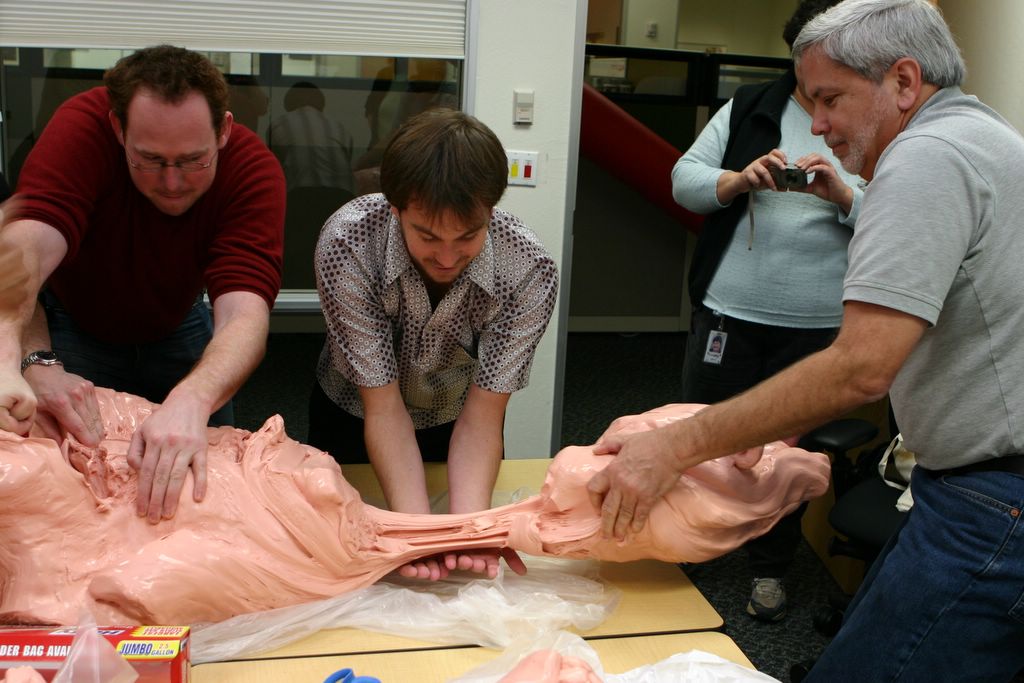
After twelve people spent two hours stabbing, twisting, and wrestling with the stuff, everyone in the group had gotten some.
(Photo from the Official Google Blog)
- A designer named Jonathan Zobro made a clock that uses Silly Putty to measure time. Except its increments are in days, not minutes or even hours.

(Photo from Jonathan Zobro's site)
- A guy named Rodger Cole who builds models used Silly Putty as a mask, to cover up one color and then spray painting the whole thing with another color.

Here's the tank with the areas he doesn't want to turn tan covered with the Silly Putty. After he sprayed on the tan color, after a few minutes it looked like the Silly Putty was melting. So he put the whole thing in the freezer. "Worked like a charm." After the paint had dried, he peeled off the Silly Putty and everything was the color he wanted it to be, and he was able to use the Silly Putty again.
(Photo from ModelGeek)
- For your Halloween needs, you can also get Blood Putty:

This stuff will stain clothes and surfaces, so don't get that bloody putty on anything important.
(Photo from Nerd Approved. Bloody Putty is available for $4.99 from Club Earth)
- Of course you can always make your own Silly Putty -- or a substance that comes awfully close.
These kids made their own Silly Putty and are justifiably proud of it.
(Photo by Tie, on PicasaWeb)
This recipe uses glue, water, and starch, plus food coloring.
Here's another recipe -- with a soundtrack, even -- that uses glue, water, and borax. The results with this one are a little more runny.
By the way, if you get Silly Putty stuck in your hair, several mothers say they had success in using Pam cooking spray and a fine tooth comb. Another mother said that hand sanitizer worked even better to get it out.
Sources
Silly Putty, Silly Science, History 101
How Products Are Made, Silly Putty
One Look, silicone, polymer, boric acid
Sightseer's Guide to Engineering, Crayola Factory
Thrifty Fun, Removing Silly Putty from Hair
Friday, October 10, 2008
Apple #345: Stuff
The past couple of days, I've caught myself using the word "stuff" way too often. In one e-mail that was about two sentences long, I used it twice. Then I heard myself say it in a conversation two times in about five minutes.
I don't mean "stuff" as a verb, but as a noun. For example, "I've got stuff I have to get done," and "Where am I going to put all that stuff?" and also as a sort of throwaway add-on at the end of a sentence: ". . . so she was being all mean, saying all kinds of insults, and stuff."
I heard myself use this word enough times, I thought, but what the heck is stuff?

The quilted material (stuff) used under chain mail was made into a padded shirt like this one, called a gambeson. Crusaders realized these shirts provided extra protection after they saw the Arab soldiers they fought wearing them.
(You can buy a gambeson like this one from Medieval Fantasies Co. for only $95! That stuff's not cheap!)

Stuff used to stuff a quilt
(Photo from Racheal Miles' blog Miles Away in France)
THE BAD STUFF

An overstuffed chair and ottoman (footstool). See, it doesn't look like it's stuffed too full so that the stuffing is coming out of it or anything, right? It just looks stuffed. Still, it's called overstuffed.
(Available from All Barstools for $529.)
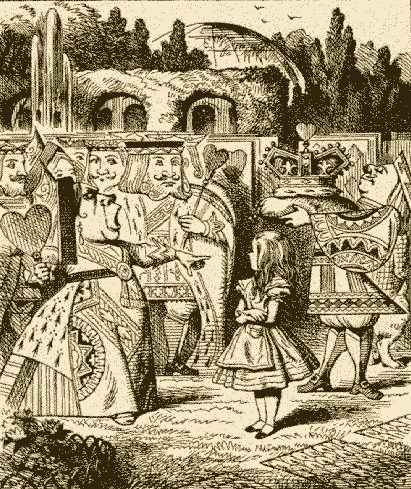
“No, no!” said the Queen. “Sentence first—verdict afterwards.”
“Stuff and nonsense!” said Alice loudly. “The idea of having the sentence first!”
(Illustration by Sir John Tenniel, sourced from ibiblio)
THE GOOD STUFF

Turkey, stuffed with stuffing
(Photo from Dressing Recipes, which has lots of tips & recipes about turkey stuffing)


The Right Stuff
So, a lot of stuff can be stuff. Now I don't feel so bad for using that word as much as I have. Because it's really useful for a lot of stuff.
Sources
Online Etymology Dictionary, stuff
Webster's 1913 Dictionary, stuff
Compact Oxford English Dictionary, stuff
Webster's New World College Dictionary, stuff
American Heritage Dictionary, stuff
Ultralingua, stuff
Brian Lavery, Part III: Underwater Protection, The Arming and Fitting of English Ships of War, 1600-1815, pages 56-58.
I don't mean "stuff" as a verb, but as a noun. For example, "I've got stuff I have to get done," and "Where am I going to put all that stuff?" and also as a sort of throwaway add-on at the end of a sentence: ". . . so she was being all mean, saying all kinds of insults, and stuff."
I heard myself use this word enough times, I thought, but what the heck is stuff?
- The first definition in most dictionaries reads something along these lines: "matter of an indeterminate kind." Thanks.
- According to the Online Etymology Dictionary, a very early definition for the noun is "quilted material worn under chain mail." This same dictionary, as well as several others, says the word is derived from an Old French word, estoffe, which means "quilted material."

The quilted material (stuff) used under chain mail was made into a padded shirt like this one, called a gambeson. Crusaders realized these shirts provided extra protection after they saw the Arab soldiers they fought wearing them.
(You can buy a gambeson like this one from Medieval Fantasies Co. for only $95! That stuff's not cheap!)
- The Online Etymology Dictionary goes further to say that estoffe probably came from an Old High German word stopfon, which means "to plug or stuff."
- In other words, the noun is the stuff -- er, material -- with which you stuff something. The stuffing with which the pillow is stuffed.

Stuff used to stuff a quilt
(Photo from Racheal Miles' blog Miles Away in France)
- From there, we get all sorts of other uses for the noun. Interestingly, sometimes the stuff is good, and sometimes it's bad.
THE BAD STUFF
- Stuff -- furniture, domestic goods, often in a somewhat dismissive sense. This actually is another meaning of the word estoffe, which also means furniture. I wonder if furniture and stuffing go together because the French were thinking of overstuffed chairs? Which, by the way, has always confused me. Why are those chairs "overstuffed," anyway? Why not just "stuffed"?

An overstuffed chair and ottoman (footstool). See, it doesn't look like it's stuffed too full so that the stuffing is coming out of it or anything, right? It just looks stuffed. Still, it's called overstuffed.
(Available from All Barstools for $529.)
- Stuff -- British, dated. A particular kind of woolen fabric, often worsted. It was also sort of coarse, and usually the people who wore clothes made of stuff were lower class, common folks. I suspect the phrase simple stuff came from this usage.
- Stuff -- medicine, potion, or also slang for narcotics. Something you drink or swallow or otherwise stuff into your body for its special effect.
- Stuff -- slang, British, for worthless trash, junk, twaddle. As in, "Stuff and nonsense!"

“No, no!” said the Queen. “Sentence first—verdict afterwards.”
“Stuff and nonsense!” said Alice loudly. “The idea of having the sentence first!”
(Illustration by Sir John Tenniel, sourced from ibiblio)
- Stuffy -- unventilated air, or the air is full of stuff. Or a person could be stuffy, too, meaning snooty or full of attitude.
- Stuffed shirt -- pompous person. Originally, someone who wore padded shirts and passed himself off as being larger or more muscular than he actually was. Later, in brief, "full of stuff."
THE GOOD STUFF
- Stuffing -- edible, seasoned mixture stuffed into, or cooked in the body cavity of a fowl.

Turkey, stuffed with stuffing
(Photo from Dressing Recipes, which has lots of tips & recipes about turkey stuffing)
- Stuff -- a gooey mess of melted wax and turpentine, used to cover the bottom of ships. Its purpose was partly to protect the wood, but it also helped the hull move more smoothly through the water. The mixture changed over the years, from white stuff, to black stuff, to brown stuff. I'm not sure if there's any connection here with the concept of stuffing something into something else.
- Stuff -- slang, in baseball, the English or spin a pitcher puts on the ball. In sports in general, some demonstration of excellence, as in, "He really showed his stuff." I suspect this is derived from the next entry.

The Right Stuff
- "The right stuff," or "made of sterner stuff" -- not physical stuff, but one's internal character, and usually meant in a flattering sense. I think of this as a shorthand way of saying, "the innards with which you are made are of a more lasting and durable nature than the usual, flopsy-mopsy quilted material with which others are stuffed."
- To know one's stuff -- well-versed in one's area of expertise. I find this phrase kind of ironic, having thought so much about the bad stuff. It sounds to me now that, by calling someone's specialized subject stuff, you're comparing it to something that's not worth very much.
- The stuff of life (or of whatever realm you happen to be discussing at the time) -- the critically important innards; the heart or the meat of the thing.
So, a lot of stuff can be stuff. Now I don't feel so bad for using that word as much as I have. Because it's really useful for a lot of stuff.
Sources
Online Etymology Dictionary, stuff
Webster's 1913 Dictionary, stuff
Compact Oxford English Dictionary, stuff
Webster's New World College Dictionary, stuff
American Heritage Dictionary, stuff
Ultralingua, stuff
Brian Lavery, Part III: Underwater Protection, The Arming and Fitting of English Ships of War, 1600-1815, pages 56-58.
Tuesday, October 7, 2008
Apple #344: Food King and Animal House
When I get tired, my brain likes to pick up a phrase and repeat it over and over and over (my brother likes to do the same thing). Today, I've had the phrase "mood swings" in my mind. But that's not the phrase my brain is repeating. Instead, it's going for the rhyme: "Food King! FoodKing FoodKing FoodKing!"
Here's an audio file containing this exclamation (it's toward the end).
This phrase, for those who don't know or remember, is from a scene in Animal House when several members of the disreputable fraternity Delta Tau Chi go to the grocery store, called Food King, and blatantly steal all kinds of food.

If you've been in a college dorm, you've probably seen this poster. It's #1 on College Happenings' top 28 dorm room posters.

Larry (Tom Hulce), his sweater stuffed full of meat, chatting with the cashier at the Food King.
(Photo from Video Adrenalin)

You may be glad to know that there are several grocery stores on the East coast that are still in operation called Food King. This store, I think, is in Washington.
(Photo from the MySpace page of someone named Valis)

Those lovable ruffians from Delta turned 30 this year.
(Photo from Nice Picture.info)
The movie recently turned 30 years old (shocking!). For you kids out there who think that means it's obsolete, here is proof that this movie remains an important cultural reference point:
By the way, you can download the entire movie for only $3 from Amazon.

Remember, Bluto went on to become a US Senator.
(Photo from Young Manhattanite)
Sources
Audio file from tfmuch.com, which has lots of audio files from Animal House
IMDB, Animal House
Here's an audio file containing this exclamation (it's toward the end).
This phrase, for those who don't know or remember, is from a scene in Animal House when several members of the disreputable fraternity Delta Tau Chi go to the grocery store, called Food King, and blatantly steal all kinds of food.
- The movie, filmed in 1978, is all about the craziness that happens at a fraternity, Delta, at the fictional Faber College.
- Actors of note included
- John Belushi
- Donald Sutherland
- Kevin Bacon (this was his first movie)
- Tim Matheson (he played VP John Hoynes on The West Wing)
- Tom Hulce (you know him from Amadeus)
- Karen Allen (you know her from Raiders of the Lost Ark)

If you've been in a college dorm, you've probably seen this poster. It's #1 on College Happenings' top 28 dorm room posters.
- I remember coming across an interview somewhere with Harold Ramis, one of the writers of the movie, in which he said that the script pretty much grew out of the three writers telling each other stories about what they had done or seen when they were in college.
- In fact, another one of the writers, Chris Miller, has written a book called The Real Animal House: The Awesomely Depraved Saga of the Fraternity That Inspired the Movie, in which he tells his stories about things he actually did or witnessed while a student at Harvard in the 1970s.
- Some of the movie's hijinks include stealing exams, stealing a car, sneaking a horse into the Dean's office, starting a food fight, finding various creative ways to get women to go on dates with them, and of course throwing toga parties.
- One of the many instances of craziness include the trip to the Food King, the local grocery store.
- Several members of the fraternity go to the store, and they fan out. Some of them hit on women (one woman turns out to be the nemesis-Dean's wife), while others load up the shopping cart and their clothes with cucumbers and meat.

Larry (Tom Hulce), his sweater stuffed full of meat, chatting with the cashier at the Food King.
(Photo from Video Adrenalin)
- Perhaps another reason this scene has stayed in my mind all this time is because my brother told me that he and his college housemates used to go on similar forays. He lived with five other guys, and they would all go to the grocery store together. They'd line the bottom of the cart with steaks and ground beef, because that's the most expensive thing in the store, and put all the other stuff on top of it.
- Then when it was time to go through the checkout lane, one or two guys would unload, while another one or two guys would go ahead of the cart and bag. The guys unloading would talk to the cashier and keep her distracted while the guys doing the bagging would put the full bags of paid-for groceries on top of the meat which was never taken out of the bottom of the cart. Then they'd wheel the whole thing out of the grocery store, cheerfully saying "have a nice day" to the cashier who thought those college boys had been so helpful.
- According to a guide to the movie for English-as-a-second-language viewers, Food King is the name of grocery stores that actually do exist, as well as the fictional store in the movie.

You may be glad to know that there are several grocery stores on the East coast that are still in operation called Food King. This store, I think, is in Washington.
(Photo from the MySpace page of someone named Valis)
- Animal House was filmed on the campus of the University of Oregon, in Eugene, and in nearby Cottage Grove. The exterior of Delta house was a building that, at the time of filming, was a halfway house for former prisoners.
- This site (Acme Animal House) has lots of information about locations used in the movie, as well as photos. Unfortunately, no photo of the Food King.

Those lovable ruffians from Delta turned 30 this year.
(Photo from Nice Picture.info)
The movie recently turned 30 years old (shocking!). For you kids out there who think that means it's obsolete, here is proof that this movie remains an important cultural reference point:
- Lots of people in discussing the current banking and economic turmoil, reference Chip Diller (Kevin Bacon)'s response to the Delta's havoc during the parade, "All is well, remain calm."
- Even a Canadian, talking about their upcoming elections, made this reference.
- Local news radio station's story on the recent decision by the University of Wisconsin to restrict its marching band from traveling and performing, in response to allegations of hazing and unsavory behavior.
- Columnist for the Baltimore Sun discussing the corruption at the Minerals Management Service, saying it's not as bad as Dick Cheney dressing up as Bluto in a toga -- but close.
- San Diego sports columnist's advises the Chargers Bluto-style after losing a close game due to a bad call.
- Local TV station cites Bluto's method of loading up his cafeteria tray with food as an example of why many cafeterias are now "going trayless."
- A political op-ed piece asks if the United States electorate is willing to say, "Thank you, sir, may I have another [eight years]?"
By the way, you can download the entire movie for only $3 from Amazon.

Remember, Bluto went on to become a US Senator.
(Photo from Young Manhattanite)
Sources
Audio file from tfmuch.com, which has lots of audio files from Animal House
IMDB, Animal House
Subscribe to:
Posts (Atom)